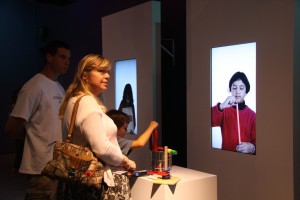 On Saturday 19 December 2009, the Expolab team consisting of Ramon Sanguesa, Astrid Lubsen and Irene Lapuente attended the Symposium “Me, you and everyone we know is a Curator” in Amsterdam, the Netherlands. There were speakers from various backgrounds, such as Bruce Sterling, Mieke Gerritzen, Rick Poynor, Andrew Keen, Sarah Cook, Willem Velthoven, Aram Bartholl or Dagan Cohen.
On Saturday 19 December 2009, the Expolab team consisting of Ramon Sanguesa, Astrid Lubsen and Irene Lapuente attended the Symposium “Me, you and everyone we know is a Curator” in Amsterdam, the Netherlands. There were speakers from various backgrounds, such as Bruce Sterling, Mieke Gerritzen, Rick Poynor, Andrew Keen, Sarah Cook, Willem Velthoven, Aram Bartholl or Dagan Cohen.
The event was opened by Mieke Gerritzen, Director of Graphic Design Museum in Breda. Mieke talked about the democratization of design, caused by the ongoing changes in technology and the tendency of society to retain control and not open the design process. She raised the possibility that there is something traditional without interference of modern culture if its existence was necessary. This she called “organic design” and se also mentioned that we live in a “do it yourself!” society.

The opening lecture was given by Bruce Sterling, who proposed a couple of metaphors that were used throughout the entire symposium. Sterling said that the digital revolution had already taken place, and while we were facing a new decade we have to await the results of this unplanned revolution without anchors of the past.According to Bruce Sterling people of the new society can no longer see technology as something positive that has transformed the way of doing things because they simply do not remember how they did these things before, without technology. They see technology only as a methodology, a way of doing things. At the moment this revolution has left us with processes, actions and institutions that he calls the “Gothic Hi Tech”. On the other hand, people who are creating other processes, actions or institutions that are less archaic and planned. He called this second type the “favela chic”; identifying it with the cultural processes of appropriation of technology in these settlements. Sterling defended the technology of the “favela chic” type. Although “favela chic” could appeare disorganized, unstructured and poor, it is truly innovative and revolutionary.However, structures built with Gothic and heritage of the past, have wiped out the possibility of creating fresh things. Finally, he explored the dilemma that might arise from mixing the language of technology and the structures of “favela chic” that are constantly changing, and conservation efforts of museums.A possible solution to the dilemma would be to stop considering the museum as tombs for conversion projects in nurseries, laboratories, etc.
Later during the morning, Julia Noordegraaf, director of the Master “Preservation and Presentation of the Moving Image” from the Media Studies Department at the University of Amsterdam discussed the issue of considering the exhibition curators and publishers. Then, Sarah Cook, co-editor of CRUMB (the Curatorial Resource for Upstart Media Bliss) and researcher at the University of Sunderland gave an interesting presentation on curatorial strategies for artistic production on-line.She showed excellent examples of mixing fiction and reality within a museum. Later, Rick Poynor, design critic (one of the authors of “Design Observer“) and writer showed an interesting overview of various design blogs, and raised the issue of copying without improving and not remunerate the work of the people working, writing and managing blogs worldwide. Almost ready to go have lunch, a member of Metahaven, a design and research studio based in Amsterdam presented us graphic design concepts and strategies of communication. The morning session concluded with Sophie Krier, organizer and designer of the symposium, who discussed the whole process of designing the event.
We had a short half-hour to grab some lunch before proceeding with the afternoon speeches. Andrew Keen, a known author and conference speaker, demonstrated avery critical and negative vision. Raising the question of how a technological society economically supports itself he promoted the return to traditional roles of exhibition curators as key teachers of culture.
 While Andrew Keen tried to redirect the symposium to catastrophist criticism, the following talks during the afternoon were not of such kind but quite the contrary. Willem Velthoven of Mediamatic, Aram Bartholl Berlin and Dagon Cohens Upload Cinema. project filled the hall with fascinating and incredibly interesting examples that were the opposite of what Keen preached.
While Andrew Keen tried to redirect the symposium to catastrophist criticism, the following talks during the afternoon were not of such kind but quite the contrary. Willem Velthoven of Mediamatic, Aram Bartholl Berlin and Dagon Cohens Upload Cinema. project filled the hall with fascinating and incredibly interesting examples that were the opposite of what Keen preached.
Willem Velthoven talked about an exhibition co-created with artists from around the world. After the symposium, the Expolab team felt encouraged by the words of Willem Velthoven, and visited the exhibition at the headquarters of Mediamatic. Our experience was really of a of the quality that he spoke about.The German creative Aram Bartholl showed us artistic examples where digital and analog go hand in hand, being transformed into something surprising and appealing.  Finally, Dagon Cohen presented a proposal where the Internet would be the salvation of traditional cinema and its traditional form to be distributed. We have to say that due to timing issues we could not see a full movie produced by Upload Cinema, but the small pieces that showed us left us with a great desire to participate in it!
Finally, Dagon Cohen presented a proposal where the Internet would be the salvation of traditional cinema and its traditional form to be distributed. We have to say that due to timing issues we could not see a full movie produced by Upload Cinema, but the small pieces that showed us left us with a great desire to participate in it!
The symposium ended with a discussion moderated by Henk Oosterling and the whole event was moderated by Koert Van Mensvoort. ! It was quite a symposium! A very interesting day, where we met people from the design world, museums, technology, with interesting things to say and success stories to show. The three of us enjoyed the symposium, visiting exhibitions and shopping in Amsterdam and visiting the country left us with an excellent feeling. We also opened contacts with a few of the participants and visited a couple of institutions to start preparing new projects.A great beginning!
 Today, The Tech Museum president, Dr. Peter Friess, officialy opened the exhibition “The Tech Challenge Gallrey”. This exhibition shows to new visitors, more than forty totally interactive experiments prepared, narrated and explained by other visitors: boys and girls that have collaborated in this gallery explaining experiments on video.
Today, The Tech Museum president, Dr. Peter Friess, officialy opened the exhibition “The Tech Challenge Gallrey”. This exhibition shows to new visitors, more than forty totally interactive experiments prepared, narrated and explained by other visitors: boys and girls that have collaborated in this gallery explaining experiments on video. Finally, other new visitors will be able to experiment and understand science thanks to the videos recorded by other previous visitors: the girls and boys we have alreadya mentioned. Everyone, eventually could become the start of the “Tech Challenge Gallery”, because this is a process that is alive and well and will be kept going by all people involve, staff and visitors alike.
Finally, other new visitors will be able to experiment and understand science thanks to the videos recorded by other previous visitors: the girls and boys we have alreadya mentioned. Everyone, eventually could become the start of the “Tech Challenge Gallery”, because this is a process that is alive and well and will be kept going by all people involve, staff and visitors alike. This exhibition, however, is not only for kids. Adults can also enjoy it. The Expolab Team (Irene Lapuente and Ramon Sangüesa) have been there too and enjoyed playing with wheel gears, peg tops and prisms. We think that this kind of initiatives help not just to bring science close to people but also let the younger ones appropriate by science themselves. Congratuilations to the Tech!
This exhibition, however, is not only for kids. Adults can also enjoy it. The Expolab Team (Irene Lapuente and Ramon Sangüesa) have been there too and enjoyed playing with wheel gears, peg tops and prisms. We think that this kind of initiatives help not just to bring science close to people but also let the younger ones appropriate by science themselves. Congratuilations to the Tech!

 On Saturday 19 December 2009, the Expolab team consisting of Ramon Sanguesa, Astrid Lubsen and Irene Lapuente attended the Symposium
On Saturday 19 December 2009, the Expolab team consisting of Ramon Sanguesa, Astrid Lubsen and Irene Lapuente attended the Symposium
 While Andrew Keen tried to redirect the symposium to catastrophist criticism, the following talks during the afternoon were not of such kind but quite the contrary. Willem Velthoven of
While Andrew Keen tried to redirect the symposium to catastrophist criticism, the following talks during the afternoon were not of such kind but quite the contrary. Willem Velthoven of Finally, Dagon Cohen presented a proposal where the Internet would be the salvation of traditional cinema and its traditional form to be distributed. We have to say that due to timing issues we could not see a full movie produced by
Finally, Dagon Cohen presented a proposal where the Internet would be the salvation of traditional cinema and its traditional form to be distributed. We have to say that due to timing issues we could not see a full movie produced by